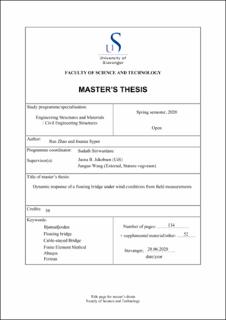| dc.contributor.advisor | Wang, Jungao | |
| dc.contributor.advisor | Jakobsen, Jasna Bogunovic | |
| dc.contributor.author | Syper, Joanna | |
| dc.contributor.author | Zhao, Ran | |
| dc.coverage.spatial | Norway | en_US |
| dc.date.accessioned | 2020-09-25T11:27:47Z | |
| dc.date.available | 2020-09-25T11:27:47Z | |
| dc.date.issued | 2020-06-28 | |
| dc.identifier.uri | https://hdl.handle.net/11250/2679710 | |
| dc.description | Master's thesis in Structural engineering | en_US |
| dc.description.abstract | The long and slender floating structures across the wide and deep waters are exposed for considerable environmental loads. In this study, the dynamic response of a curved floating pontoon bridge supported by side mooring lines subjected to aerodynamic loads is investigated. The studied concept K12_05 is one of the concepts suggested by The Norwegian Public Roads Administration for fjord crossing at Bjørnafjorden.
The finite element model of the Bjørnafjorden floating bridge is developed in the Abaqus software. The studied floating bridge concept has a complex geometry with variable curvature along the vertical and horizontal plane. The bridge is firstly examined in modal analysis in terms of eigenfrequencies and eigenmodes. Bridge responses under static wind considering various wind directions and different spatial distributions are studied. Furthermore, bridge dynamic responses considering aerodynamic loads characterized by quasi-static buffeting theory are studied by using time domain analysis. The turbulent wind field is simulated considering wind spectral and coherence parameters given by the design guidelines and from field measurements. Fortran subroutines are developed to integrate with Abaqus to calculate the instantaneous wind loads. Six realizations of each characteristic wind condition are generated to represent the randomness of the wind field in time domain. The bridge dynamic responses are presented and discussed in the forms of mean displacement, standard deviation and maximum responses. The power spectral density of the bridge response is also calculated and compared with modal information of the structure. Finally, sensitivity analysis on wind spectral and coherence parameters was studied. | en_US |
| dc.language.iso | eng | en_US |
| dc.publisher | University of Stavanger, Norway | en_US |
| dc.relation.ispartofseries | Masteroppgave/UIS-TN-IMBM/2020; | |
| dc.subject | materialteknologi | en_US |
| dc.subject | byggkonstruksjon | en_US |
| dc.subject | cable-stayed bridge | en_US |
| dc.subject | finite element method | en_US |
| dc.subject | abaqus | en_US |
| dc.subject | fortran | en_US |
| dc.subject | Bjørnafjorden floating bridge | en_US |
| dc.title | Dynamic response of a floating bridge under wind conditions from field measurements | en_US |
| dc.type | Master thesis | en_US |
| dc.subject.nsi | VDP::Teknologi: 500::Materialteknologi: 520 | en_US |
